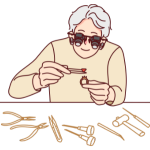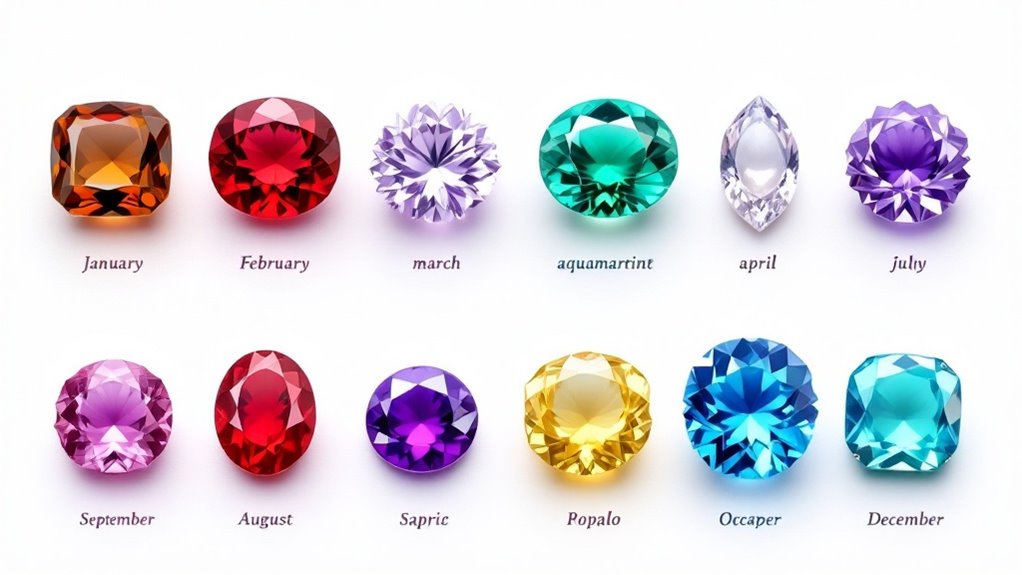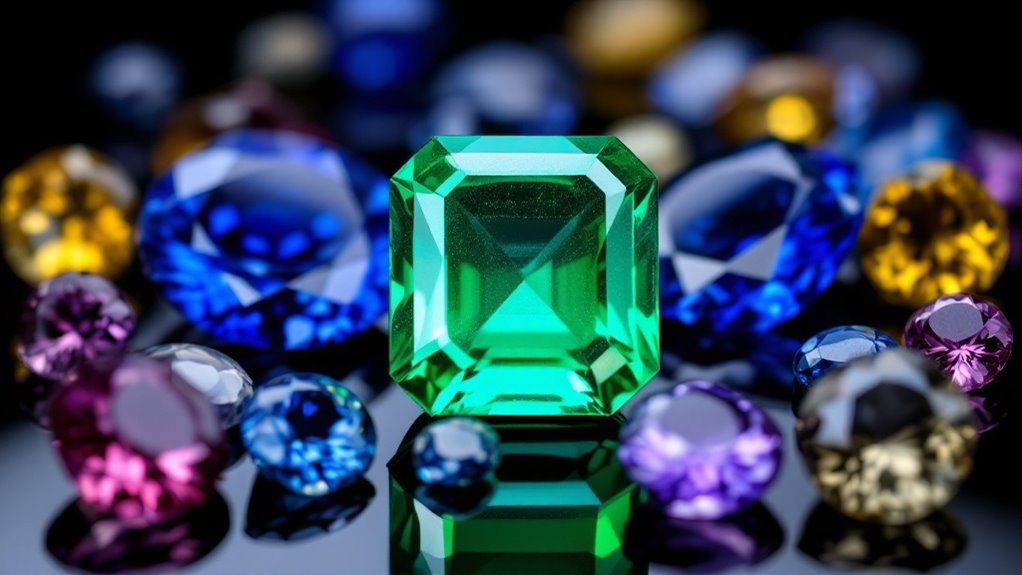Choosing the right size and style of bead caps enhances jewelry design. Small caps suit large beads, while large caps finish pieces beautifully. Matching colors creates cohesion, with gold or silver adding elegance. Small caps offer subtle accents; large ones elevate multi-strand designs. Mixing materials and styles adds interest, and decorative or vintage caps create focal points. Secure caps with E6000 adhesive for durability. Discover how to transform designs with innovative combinations.
Choosing the Right Size and Style of Bead Caps
Selecting the appropriate size and style of bead caps is essential for achieving a harmonious and polished look in jewelry design. Bead cap styles range from antique to colorful finishes, each enhancing the design’s aesthetic. Small bead caps suit larger beads, creating a balanced contrast, whereas larger caps are ideal for finishing necklaces or bracelets. It’s vital that the holes or loops of larger caps accommodate the cord dimensions, ensuring a secure fit. Cone-shaped caps are particularly useful for tidying grouped beads in multi-strand projects. Layering various styles and materials can add depth, encouraging creative exploration in unique jewelry.
Matching Colors for a Cohesive Design
In crafting jewelry, selecting bead caps in shades that complement or match the main beads is essential for achieving a cohesive design. Utilizing metallic bead caps in gold or silver can infuse elegance, while contrasting vibrant caps with muted beads can create striking visual interest. By coordinating bead cap colors with the overall palette, designers can guarantee a unified and sophisticated aesthetic in their creations.
Coordinating Bead Cap Shades
When crafting jewelry, coordinating bead cap shades with the primary beads is essential for achieving a cohesive design. Bead cap techniques involve selecting complementary colors, such as gold caps with warm-toned beads or silver with cooler hues. Using contrasting shades, like dark caps on light beads, can highlight focal points, adding depth and interest. Metal finishes, such as antique or brushed, further enhance the aesthetic, ensuring harmony with the beads’ style. Layering shades in a graduated color scheme enriches the design, while decorative caps with patterns or textures can match and elevate the piece’s visual appeal, creating a unified look.
Harmonizing Color Combinations
While designing jewelry, achieving a cohesive design relies heavily on harmonizing color combinations between bead caps and the beads themselves. When selecting bead cap materials, considering the bead colors is essential. Metallic finishes like gold and silver complement both warm and cool palettes, enhancing the overall design. Utilizing contrasting colors, such as deep blue beads with antique gold caps, adds visual interest. Experimenting with layering different shades of the same color can create harmony and dynamism, such as varying shades of green. Decorative bead caps with intricate designs can elevate simple schemes, while neutral caps allow vibrant beads to stand out.
Utilizing Small Caps for Subtle Accents
Artists and jewelry makers often enhance their creations by incorporating small bead caps, which serve as subtle yet impactful accents. These small caps, often resembling half beads, enhance the visual impact of larger beads, providing a polished and cohesive look. They can be packaged in quantities of 30 to 50, making them ideal for various projects. Gold or silver caps add elegance to elastic bracelets and other jewelry designs. By placing small caps on either side of focal beads, creators achieve smooth shifts between different bead sizes. Experimenting with color combinations and layering adds depth and encourages creativity in design.
Enhancing Multi-Strand Designs With Large Caps
Large bead caps play a pivotal role in enhancing multi-strand jewelry designs, providing both functional and aesthetic benefits. These caps, often featuring holes or loops, suit various cord dimensions and offer a polished finish. Incorporating decorative bead caps adds visual interest and cohesion to designs. When selecting caps, it’s essential to balance the size and weight of the beads. Bead cap tutorials suggest experimenting with different styles and colors to transform simple designs into intricate masterpieces.
| Feature | Benefit | Consideration |
|---|---|---|
| Holes or Loops | Versatile for various cords | Matches with bead size |
| Decorative Elements | Adds visual interest | Unifies strands |
| Style and Color Variety | Elevates design appeal | Avoid overpowering the design |
Adding Dimension With Cone-Shaped Caps
Cone-shaped bead caps offer a sophisticated solution for adding dimension and structure to jewelry designs. These caps provide a tidy, polished finish for clusters of beads, enhancing the aesthetic appeal. Available in materials like antique gold and copper, they lend elegance to both casual and formal pieces. In multi-strand projects, cone-shaped caps effectively organize and visually separate different bead types, maintaining design cohesion. When selecting these caps, consider bead cap sizes relative to the beads used to guarantee a proper fit and ideal impact. Additionally, layering cone-shaped caps with other elements creates depth and interest, fostering innovative jewelry creations.
Securing Your Design With E6000 Adhesive
E6000 adhesive is a top choice for ensuring a strong bond in jewelry designs, particularly when working with metal bead caps. Its resistance to water and temperature fluctuations enhances the longevity of the piece, making it ideal for various conditions. For best results, a small amount should be applied to the cap, pressed firmly, and allowed to cure for at least 24 hours in a well-ventilated area.
Ensuring Strong Bond
Crafting jewelry that endures requires selecting the right adhesive to secure key components like bead caps. E6000 is highly recommended for its strong bond, flexibility, and durability. It guarantees that bead caps stay in place even with regular wear. A small amount should be applied to prevent overflow, maintaining the design’s aesthetic. Adequate drying time, usually 24 to 72 hours, is vital for a robust bond. Additionally, using E6000 in a well-ventilated area is necessary due to its potent fumes.
| Key Aspect | E6000 Adhesive |
|---|---|
| Bond Strength | Strong, ideal for bead caps |
| Drying Time | 24 to 72 hours |
| Ventilation Need | Essential due to strong fumes |
Metal Application Tips
Securing metal bead caps in jewelry design demands meticulous attention to detail, particularly when using E6000 adhesive. This strong bonding agent is highly recommended for its durability in securing bead caps and various jewelry findings. To guarantee peak adhesion, a small amount should be applied to clean and dry surfaces, preventing dirt or moisture from weakening the bond. Allowing the adhesive to cure for at least 24 hours is vital for achieving maximum strength, especially for pieces subject to movement or stress. For intricate designs, using a toothpick to apply E6000 helps maintain precision and neatness around bead caps.
Enhancing Jewelry Longevity
Making certain that metal bead caps remain firmly attached is a key aspect of creating lasting jewelry pieces. E6000 adhesive is highly recommended for securing bead caps due to its strong, durable bond. This adhesive dries clear and flexible, ideal for various materials in jewelry design. It enhances longevity by resisting wear while preserving design integrity. Proper application involves a clean surface and 24-hour drying for maximum strength. Safety is vital; work in a ventilated area and wear gloves to avoid skin contact.
| Key Feature | Benefit |
|---|---|
| Dries Clear | Maintains aesthetic |
| Flexible Bond | Withstands movement |
| Strong Adhesion | Guarantees durability |
Experimenting With Mixed Materials and Styles
While exploring the art of jewelry design, the use of mixed materials and styles can transform ordinary pieces into extraordinary creations. Incorporating bead caps of varying sizes and colors introduces visual interest, allowing designers to blend metals like gold and silver seamlessly. Decorative bead caps serve as essential jewelry embellishments, offering texture and contrast when paired with antique or modern styles. Jewelry design tips suggest experimenting with cone-shaped bead caps alongside larger beads for polished finishes in multi-strand creations. Utilizing materials like leather or fabric alongside bead caps can inspire creative jewelry designs, showcasing unique layering techniques and personal style.
Creating Focal Points With Decorative Caps
Decorative bead caps play an essential role in jewelry design by serving as striking focal points that enhance the visual impact of larger beads. By framing these beads, bead caps add contrast and intricate patterns, elevating the overall design. Pairing decorative caps with complementary beads guarantees a cohesive look that highlights the focal arrangement. Experimenting with various styles, whether antique or modern, can alter the aesthetic and create unique focal points. Additionally, layering multiple bead caps adds depth, while cone-shaped caps polish a bead cluster, directing attention to the center.
- Consider contrasting colors for maximum impact.
- Layer caps for added depth.
- Use cone-shaped caps for focus.
- Pair with complementary beads for cohesion.
Exploring Vintage and Antique Cap Designs
Incorporating vintage and antique bead caps into jewelry design introduces a touch of elegance and historical charm. These bead caps often boast intricate designs, such as filigree or patina finishes, adding unique allure to jewelry crafting. Available in metals like brass, copper, and silver, they provide diverse aesthetic options, seamlessly blending with both modern and retro designs. Antique caps are particularly effective in multi-strand jewelry projects, enhancing the visual impact and cohesion of combined beads. By evoking nostalgia and craftsmanship, they appeal to enthusiasts who admire historical elements, encouraging creative layering and the innovative mixing of materials in personalized pieces.
Innovating With Unconventional Cap Combinations
How can jewelry designers push the boundaries of creativity? By exploring innovative combinations of bead caps in DIY jewelry, they can produce striking and unique pieces. Mixing small and large bead caps creates visual contrast, enhancing the design without overshadowing focal beads. Incorporating cone-shaped caps with decorative leather offers a polished finish for multi-strand creations. Layering antique and modern styles adds depth, while glue-in caps with loops streamline intricate designs. Combining bead caps of varying colors and materials fosters a cohesive yet eclectic look. Embrace experimentation for personal expression.
- Mix small and large bead caps
- Use cone-shaped caps with leather
- Layer antique and modern styles
- Try glue-in caps with loops
Conclusion
Incorporating bead caps into jewelry designs offers a multitude of creative possibilities. By selecting the appropriate size, style, and color, designers can achieve cohesive and visually appealing pieces. Small caps provide subtle accents, while larger caps enhance multi-strand designs. Cone-shaped caps add dimension, and decorative caps create focal points. Exploring vintage designs and experimenting with unconventional combinations further expands creative horizons. With these tips, jewelry makers can elevate their craft, transforming simple beads into stunning works of art.





Leave a Reply